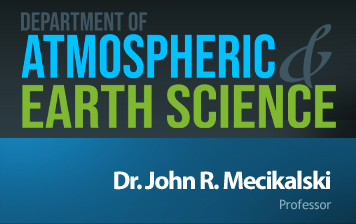2023
AES 472/AES 572 – Satellite Meteorology
The goal for this course is to provide students in undergraduate and graduate level Atmospheric and Earth Science a background in satellite meteorology. During all components of the course there will be a heavy emphasis on practical meteorological satellite interpretation with respect to land surface and especially atmospheric features. The course syllabus will generally follow that of the required textbook for this class, yet will cover other topics relevant to current-day meteorological satellite systems as available in other reports, science papers and manuscripts, and will also rely on material in UCAR COMET Program on-line modules and other on-line training materials. During all components of the course (as outlined in the syllabus) there will be a heavy emphasis on practical meteorological satellite interpretation with respect to land surface and especially atmospheric features. The main course objectives are to help students form an understanding of the basic science concepts of operational satellite meteorology, understand methods of meteorological satellite imagery interpretation, and obtain an introduction to satellite data and image processing tools.
AES 652 – Advanced Synoptic Meteorology
This class expands on introductory synoptic meteorological topics, and will provide a balance between theory and practical applications toward describing synoptic-scale phenomena, including air masses, frontal systems, cyclones, anti-cyclones, tropical cyclones and associated mesoscale components. Heavy emphasis is placed on building an understanding of potential vorticity theory and understanding synoptic weather via isentropic analysis. This will be accomplished where possible through use of satellite data, NWP models, and workstations that involve remote sensing. In-class instruction will be complimented by applications involving hands-on weather interpretation, map and forecast discussions, forecast presentations, and case study analyses. Use of NWS/COMET web-based modules will enhance the instruction.
AES – Tropical Meteorology
This course draws together concepts in the dynamics and climatology of the tropical atmosphere, as well as of significant precipitation systems across the Tropics. Specific topic areas include synoptic climatology, the dynamics of tropical flows (e.g., Kelvin waves, near Equatorial flows), convective scale dynamics, island meteorology, tropical cyclones, and the broad forces driving tropical circulations (e.g., ENSO, radiative-convective equilibrium, latent heating distributions, gregarious cloud systems). A review of key low-latitude jets, tropical storms, and oceanic currents, will be provided. Several of these concepts will be motivated by reading and discussing (in class) current scientific papers, for which participation by all students will be important and constitute a percentage of the final course grade.
AES 657 – Nowcasting–Theory Methods & Applications
The goal for this course is to provide students in graduate-level Earth and atmospheric science a broad background in short-term forecasting and nowcasting, involving exercises of relevant techniques using remote sensing and other observations (e.g., satellite, radar) and datasets. The class will cover aspects of short- and very-short range related to weather and other subject areas (e.g., ecological prediction) in the 0{4 hour timeframe, a forecast time period when numerical weather prediction (NWP) and other models typically do not have high skill (especially for clouds and convective precipitation). As part of the course, specific topics covered will include the definition of nowcasting as related to extrapolation-based forecasting theory, NWP model initialization and the forecast \spin-up" problem, predictability theory, a brief review of data assimilation methods, aspects of conceptual models, how various statistical methods can be used for nowcasting, an overview of several existing nowcasting systems presently in use world-wide, as well as how various end users validate and incorporate such forecast information. The class will emphasize practical applications that solve important problems, as a means of providing students hands-on examples to build expertise. Students will work with real data, and therefore should have programming experience in IDL, Python, Matlab (or other languages), and some background in common data formats such as NetCDF.
AES 675 – Atmospheric Data Assimilation
This course will review concepts of objective analysis methods relevant to atmospheric science, atmospheric data assimilation, and remote-sensing based data assimilation procedures. In the process of presenting the above three areas, in-depth discussions of numerical weather prediction (NWP), the governing atmospheric dynamic equation sets, and the characteristics of the data sources used within NWP models will be provided. The goal of the course is to provide students in graduate level atmospheric science a broad background into atmospheric data assimilation, while focusing on several exercises of assimilation techniques. This is done through projects as a means of providing students hands-on examples to build expertise. Homework assignments will involve use of common programming languages. The course also brings in real-world data assimilation examples using the Weather Research and Forecasting (WRF) modeling platform.
AES 740 – Cloud Processes
This course will overview cloud processes, beyond the scales of cloud physics and microphysics, up to and including mesoscale processes that maintain and develop clouds (the mesoscale, 250-2500 km), and mesoscale circulations that result from cloud systems. Therefore, an overview of moist dynamics will be provided from both an analytic and modeling perspective. As dynamic and thermodynamic processes are reviewed, topics related to various cloud types and cloud systems will be provided. This class will also provide students in graduate level atmospheric science a background cloud-scale processes, as well as an understanding of the dynamic and thermodynamic aspects of clouds in concert with cloud-physics and mesoscale meteorology.

